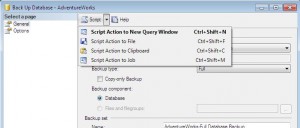If you don’t know (and that’s a good thing in this instance), cliconfg.exe is one of those older-than-dirt parts of Windows that is still around because it serves a specific purpose. In this case, it is used to configure SQL Server connection aliases.
Aliases are basically an abstraction between a SQL Server Instance’s actual connection string information (DNS name, Instance name, port, etc) and the name used by a client to connect to it. In this case, “client” can be either code/an application or a user. I know aliases are mostly evil, however some people do use them extensively. I don’t know that they’re all bad, but that’s a different post for a different time.
x86 cliconfg.exe vs x64 cliconfg.exe
Sit down at any remotely-modern Windows machine (it’s been there since 2000) and you can bring up a Run box, type “cliconfg”, press ENTER, and the utility will launch. If you do this on a 64-bit build of Windows, the 64-bit version of the utility will launch, as you might expect. This sounds good at first, but it might not be.
The first problem this presents is there is absolutely zero way to tell from within the utility itself which version of it is running. Therefore, if you’ve just moved from a 32 to 64-bit machine, there isn’t anything that might get your attention and suggest that anything unexpected is going on. This has probably happened a long time ago for some, but if you’re a corporate monkey like I am, you might have only recently been able to make the jump to a 64-bit OS.
The ultimate issue that crops up stems from why there are two versions of cliconfg.exe in the first place. In short, Windows keeps separate lists of aliases, one used by 32-bit applications and the other by 64-bit. These lists are maintained by their respective versions of cliconfg.exe. These lists are completely independent, and are only accessible by applications compiled with the same bit width.
In order to launch the 32-bit version of cliconfg, it has to be run from the folder it’s in. The path to this file is %SystemDrive%\Windows\sysWOW64\cliconfg.exe. As mentioned, it looks (and acts) just like the 64-bit version. I’d think that the folder should be named “sysWOW32” instead, but what do I know?
Which one to use?
Setting up aliases needs to be slightly planned out, although the same aliases can just be set up on both “sides”, and call it done. If one chooses not to do that, it’s a matter of thinking about what apps are going to
be utilizing any given alias, and then setting that alias up on the same bit width as the app. For example, to use an alias from within SQL Server Management Studio, the alias needs to be set up on the 32-bit side, as SSMS is still a 32-bit application.
Plan B (or Plan A?)
Here’s a different idea: Don’t use cliconfg.exe!
It’s old. I have a feeling it will go away some day. It isn’t very clear on what you are doing (32 vs 64-bit). All problems. Instead, consider using the SQL Server Configuration Manager. It’s new(er). It’s part of SQL Server, so it will probably be around for at least a bit. It is also very clear about the difference between 32 and 64-bit aliases.
For the current topic of conversation, that last point is the most important one. On a 64-bit machine, the Config Manager will have two Native Client items in the tree view in the left pane, one for 64-bit and the other for 32. Aliases configured in one do not show up in the other, making it perfectly clear what is going on.
I know that aliases are bad; using cliconfg.exe to manage them is arguably worse. However, if the situation exists that they need to be used, care needs to be taken in 64-bit client environments. The best way to deal with this situation is to use Configuration Manager.










